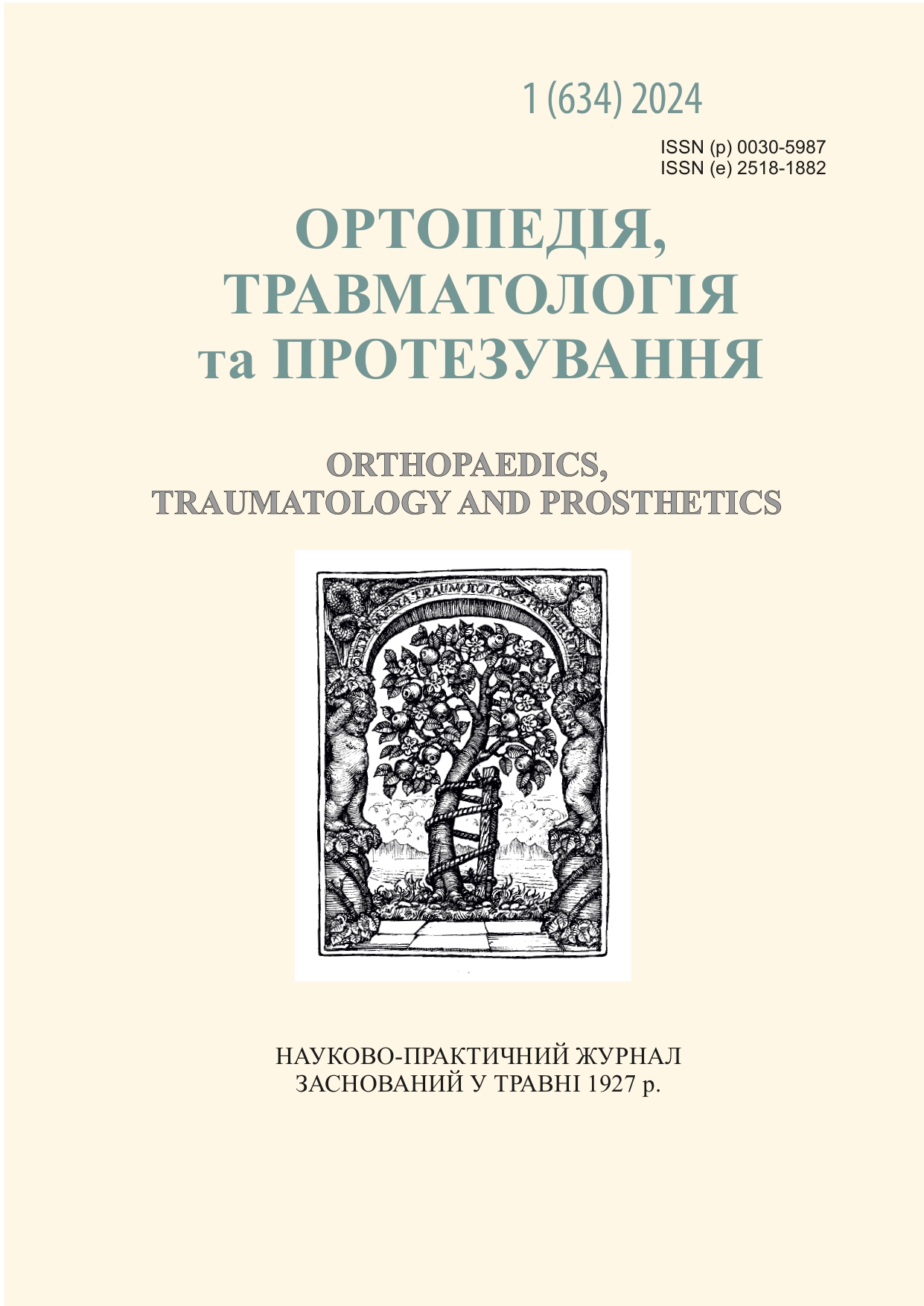Comparative Characteristics of Patients Structure in the Orthopedics Department of a Clinical Hospital in a Region Remote from the Front Line during Peacetime and the First Year of a Full-Scale War in Ukraine
DOI:
https://doi.org/10.15674/0030-59872024159-63Keywords:
Orthopedics Department, clinical-nosological structure of patients, organization of the treatment process, Oртопедо-травматологічне відділення, клініко-нозологічна структура пацієнтів, організація лікувального процесуAbstract
Objective. To analyze changes in the nosological structure of patients, treatment technologies, to outline the peculiarities
of surgical interventions in the trauma profile of a civilian clinical hospital during the war period and to emphasize the need
for relevant knowledge and skills of specialists in the treatment of combat trauma and its consequences.Methods. A comparative analysis of the clinical and nosological structure of 2,475 patients were treated during the year before the war and 3,838 patients during the full-scale war year. Among them, 83.1 % were civilians, 7.7 % were temporarily resettled, and 9.2 % were military personnel. The study utilized bibliosemantic, medical-statistical, and clinical methods. Results. During the active phase of the war, the Orthopedics Department of the civilian clinical hospital provided specialized medical assistance to both civilian populations and military personnel injured during hostilities. The relative number of hospitalized men increased by 4.83 %, and although the absolute number of those urgently hospitalized decreased. Despite the overall increase in the number of
operations per patient, surgical activity in the Orthopedics Department decreased from 86 to 80 %. The intensification
of inpatient treatment organization, patient preparation for subsequent stages of surgical interventions in the Rehabilitation
Department, and outpatient medicine work collectively reduced the average bed-day in the Orthopedics Department by 12.3 %.
Conclusions. Thus, during the war, the structure of patients in the Orthopedics Department of the civilian medical clinical
institution changed, with an increase in the relative number of male patients and those with multiple and combined injuries.
A notable feature of the treatment process organization during hostilities is the phasing of the treatment of the wounded not
only at the levels of medical evacuation but also within the clinical hospital. The intensification of the organizational component
and the outpatient link of the treatment process allowed for a reduction in bed-days and the provision of inpatient treatment to
a larger number of patients.
References
- Burianov, O., Yarmoliuk, Y., Derkach, S., Klapchuk, Y., & Los, D. (2023). Optimization of the treatment system for
- victims with long-bone gunshot fractures. TRAUMA, 24(3), 38–44. https://doi.org/10.22141/1608-1706.3.24.2023.953
- Cross, J. D., Ficke, J. R., Hsu, J. R., Masini, B. D., & Wenke,J.C. (2011). Battlefield Orthopaedic Injuries Cause the Majority
- of Long-term Disabilities. American Academy of Orthopaedic Surgeon, 19, S1–S7. https://doi.org/10.5435/00124635-
- -00002
- Nam, J. J., Do, W. S., Stinner, D. J., Wenke, J. C., Orman,J. A., & Kragh, J. F. (2017). The Highest-Impact Combat Orthopedic
- and Extremity Injury Articles in the Past 70 Years: A Citation Analysis. Journal of Special Operations Medicine, 17(1), 55.
- https://doi.org/10.55460/5u6i-i4oa
- Holm, E., Cook, J., Porter, K., Nelson, A., Weishar, R., Mallory, T., Cantor, A., Croft, C., Liwag, J., Harrington, C. J., & DesRosiers, T. T. (2022). A Quantitative and Qualitative Literature Analysis of the Orthopedic Surgeons’ Experience: Reflecting on 20 Years in the Global War on Terror. Military Medicine, 1–8. https://doi.org/10.1093/milmed/usac219
- Stewart, S. K., Tenenbaum, O., Higgins, C., Masouros, S., & Ramasamy, A. (2020). Fracture union rates across a century
- of war: a systematic review of the literature. BMJ Military Health, 166(4), 271–276. https://doi.org/10.1136/bmjmilitary-2019-001375
Downloads
How to Cite
Issue
Section
License

This work is licensed under a Creative Commons Attribution 4.0 International License.
The authors retain the right of authorship of their manuscript and pass the journal the right of the first publication of this article, which automatically become available from the date of publication under the terms of Creative Commons Attribution License, which allows others to freely distribute the published manuscript with mandatory linking to authors of the original research and the first publication of this one in this journal.
Authors have the right to enter into a separate supplemental agreement on the additional non-exclusive distribution of manuscript in the form in which it was published by the journal (i.e. to put work in electronic storage of an institution or publish as a part of the book) while maintaining the reference to the first publication of the manuscript in this journal.
The editorial policy of the journal allows authors and encourages manuscript accommodation online (i.e. in storage of an institution or on the personal websites) as before submission of the manuscript to the editorial office, and during its editorial processing because it contributes to productive scientific discussion and positively affects the efficiency and dynamics of the published manuscript citation (see The Effect of Open Access).














